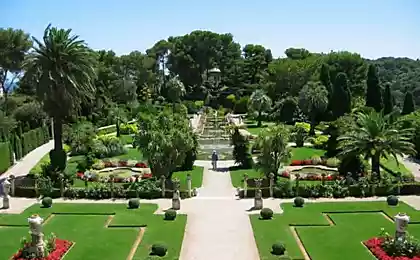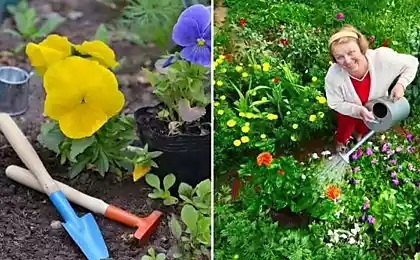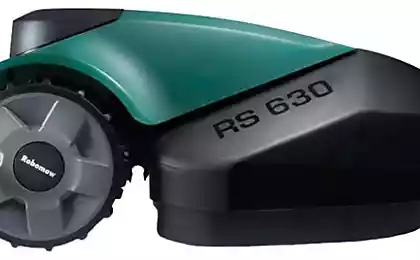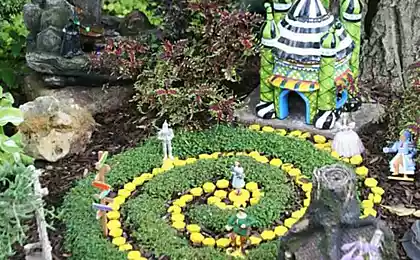595
Daisy in Your garden: growing and care
Daisy (lat. Béllis) is a unique gentle of plants of the family Asteraceae (lat. Asteráceae) or Asteraceae. The Latin name of the genus comes from the Greek word meaning "beautiful", a Russian name — from the Latin word, the translation of which is "pearl". This magnificent flower symbolizes purity and innocence, connected with it many legends and superstitions.
Daisy feel a change in the weather, their flowers before the rain closed and leans down. In ornamental horticulture is a wonderful plant emerged and gained universal love is one of the first varieties are cultivated since the XVII century. Daisies possess unique medicinal properties and is widely used in medicine.
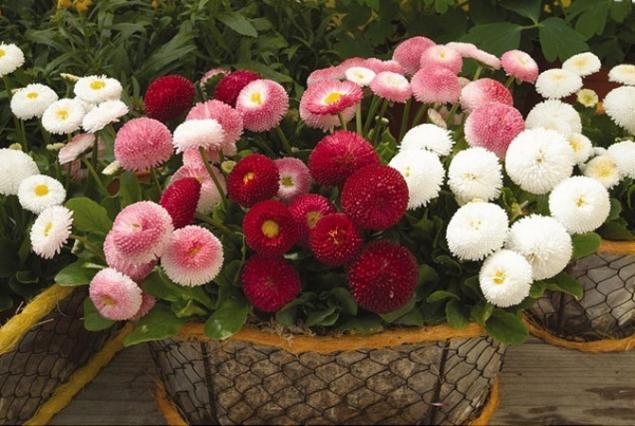
A genus of Daisy presented small herbaceous rhizomatous perennial and annual plants. Distributed in Eurasia and North America. The height of the genus from 10 to 30 cm Daisy, cultivated as a biennial: the first year develops a rosette of leaves, second – stalks, and in the third year the plant is degenerate, i.e., loses its decorative qualities.
Fibrous root system, short. The stem is erect, leafless. Leaves spatulate or oblong, collected in a compact rosette, bright green. Inflorescence — single baskets with a diameter of from 1 to 8 cm Flowers are divided into ray with diverse coloration and a Central, small, tubular, usually yellow. The petals have the form of a simple, semi-double, double. The fruit is a flattened achene with a large number of small, flat, round seeds.
It blooms from April to July, can bloom repeatedly during the season — autumn.
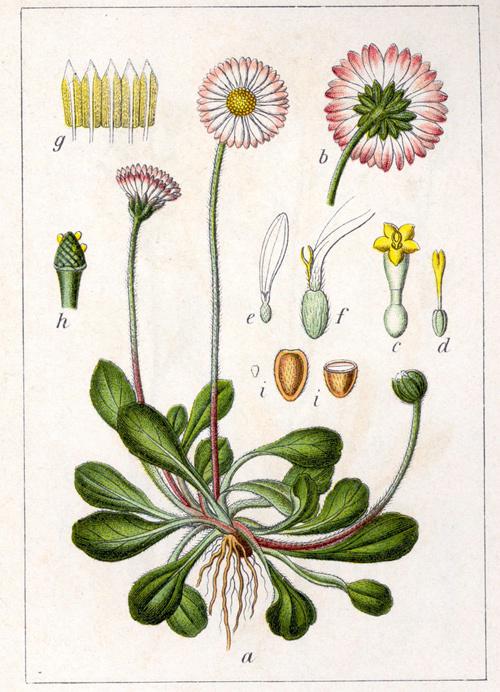
The structure of the Daisy
Species diversity and decorative tortured daisies includes nearly 30 types. Florists for decorative purposes only used 1 type — perennial Daisy (Bellis perennis), but not in the original version. Derived many new and interesting varieties, each beautiful in its own way. Not so long ago there were varieties with the regional flowers of yellow and orange colors. Modest beauty Daisy again began to attract interest and admiration, because this plant is not so ordinary as it seems.
Proof was new popular varietal series:
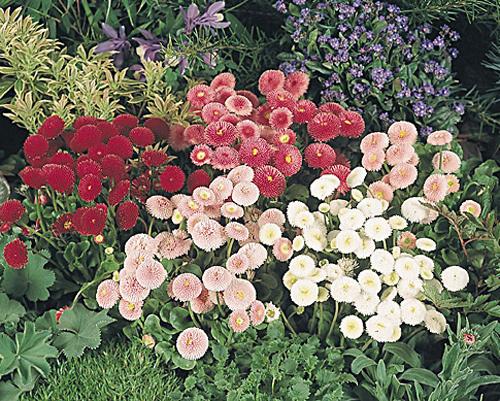
Daisies, Baskets
Many flower beds and gardens decorated with daisies such varieties: ‘Schneeball’ (‘Schneeball’) with snow white buds, ‘Beethoven'(‘Beethoven’) with pink, ‘Etna'(‘Etna’) with deep pink, ‘Pomponette’ (‘Pomponette’) — pink and scarlet blossoms of the pompon type ‘Dresden China’ (‘Dresden China’)— gustomahrovye pale pink blossoms and ‘Rob Roy'(‘Rob Roy’) — red inflorescences.
All varieties klassificeret on the structure of inflorescences: rays (var. ligunosa hort.) and tubular (var. fistulosa hort.). Each group includes varieties with simple, semi-double and double blooms. Undouble inflorescence consists of 1-3 rows of colored marginal flowers(ligulate or tubular) and the middle of the small tubular yellow flowers. Semi-double, consisting of 4 rows of painted marginal flowers yellow and small tubular parts. Terry varieties are almost completely covered with colourful regional flowers, but many varieties at full blooming begins to be noticeable the center of tubular flowers.
The size of the inflorescence can be:
Care is a liquid fertilizer of organic and mineral fertilizers at the beginning of flowering, removal of weeds, regular watering and periodic tilling of the soil. To prolong flowering and to exclude self-seeding, wither baskets you want to delete. Lack of moisture during flowering can lead to the reduction and complete disappearance of flowers.
Winteringthe Plant is very winter-hardy only in the absence of snow, severe frosts Daisy protected from the cold by covering with leaves or spruce branches. Also in the shelter are in need of varieties of plants with large flowers.
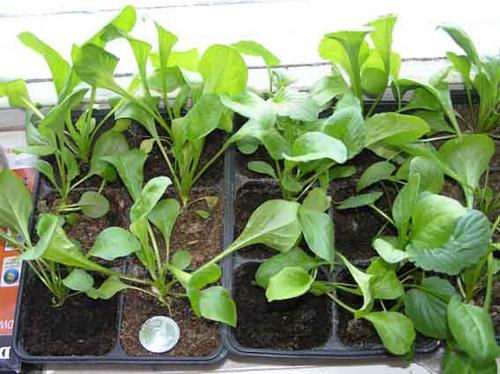
Seedlings for planting
The main methods of razmnozheniya can reproduce by seeds and vegetative method.
When seed reproduction in June-July, sow seeds in the ground, they germinate in 7-10 days. Seedlings should be thinned to distance of 10 cm between them on the areas the seedlings are placed in August, the distance between them is 20 cm are Used for planting and germination after self-seeding. The seed method does not preserve the varietal characteristics.
Valuable varieties are propagated by dividing the Bush (in the spring or in August-September), adult healthy the plant is cut nearly all the leaves, leaving the stalks and roots are pruned to 5-8 cm, pinch out the buds and flowers. After such operations, the plants rejuvenate, better root.
Cuttings for planting serve cut in may-June small shoots with a few leaves that grow in greenhouses or loose soil. Rooting occurs within two weeks and the flowers appear in the next season. Daisy and transplanted during flowering.

Powdery mildew daisies
Disease and vreditelyami quite resistant to various diseases, but adverse weather conditions and poor care of the plant condition may deteriorate.
The plant sometimes suffers from a fungal disease, usually powdery mildew (white or gray coating on leaves). Deal with it by using products containing copper, or soap solution.
Occasionally Daisy can harm the spider mite, destroy it with the help of special medications.
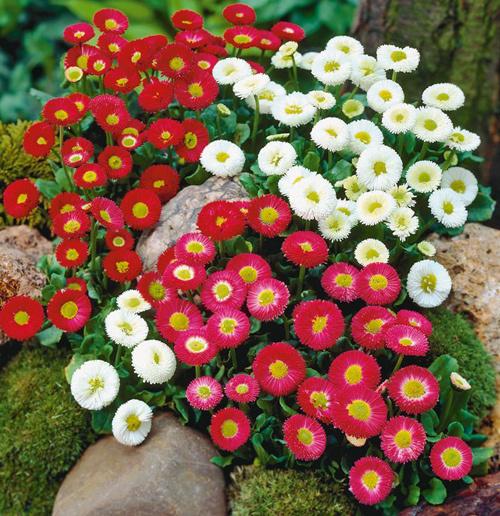
Flower garden with daisies
The use of features in the landscape diseaseimportance daisies in ornamental horticulture is quite varied, not only do they have delightful flowers, but the ornamental rosette of leaves before the onset of cold weather, the plant is compact and profusely flowering.
Daisies are a charming look to any flowerbed, lawn, borders, bright jewel colors will perfectly decorate the borders. Good neighbors daisies are an early-flowering garden plants (tulips, daffodils, hyacinths and violets), and ornamental grasses.published
P. S. And remember, only by changing their consumption — together we change the world! © Join us at Facebook , Vkontakte, Odnoklassniki
Source: 101dizain.ru
Daisy feel a change in the weather, their flowers before the rain closed and leans down. In ornamental horticulture is a wonderful plant emerged and gained universal love is one of the first varieties are cultivated since the XVII century. Daisies possess unique medicinal properties and is widely used in medicine.

A genus of Daisy presented small herbaceous rhizomatous perennial and annual plants. Distributed in Eurasia and North America. The height of the genus from 10 to 30 cm Daisy, cultivated as a biennial: the first year develops a rosette of leaves, second – stalks, and in the third year the plant is degenerate, i.e., loses its decorative qualities.
Fibrous root system, short. The stem is erect, leafless. Leaves spatulate or oblong, collected in a compact rosette, bright green. Inflorescence — single baskets with a diameter of from 1 to 8 cm Flowers are divided into ray with diverse coloration and a Central, small, tubular, usually yellow. The petals have the form of a simple, semi-double, double. The fruit is a flattened achene with a large number of small, flat, round seeds.
It blooms from April to July, can bloom repeatedly during the season — autumn.

The structure of the Daisy
Species diversity and decorative tortured daisies includes nearly 30 types. Florists for decorative purposes only used 1 type — perennial Daisy (Bellis perennis), but not in the original version. Derived many new and interesting varieties, each beautiful in its own way. Not so long ago there were varieties with the regional flowers of yellow and orange colors. Modest beauty Daisy again began to attract interest and admiration, because this plant is not so ordinary as it seems.
Proof was new popular varietal series:
- Daisy series "Baskets" (Rominette) early bloom and the height reaches about 12 cm high On strong stems attached large gustomahrovye inflorescences. Perfect for beds and borders, forms a thick volumetric flowering canvas. The series includes 4 colors, special looks interesting Carmine.
- A favorite of gardeners series "Habanera" (Habanera) has pointed Terry baskets with a diameter of about 6 cm, which will not leave anyone indifferent. 4 callers most attractive white with red tips.
- A series of "tasso" (Tasso) differs baskets pompon type, consisting of tightly adjacent to each other tubular flowers. Plant is quite compact and bloom faster than the ‘Habanera’.
- Flower breeding company "Benary" the credit belongs to the amazing variety "Robelle" (Robella) with salmon pink baskets of rolled flowers and the height of the escape of about 15 cm Grade even was awarded the gold medal of the international organization ornamental flower.

Daisies, Baskets
Many flower beds and gardens decorated with daisies such varieties: ‘Schneeball’ (‘Schneeball’) with snow white buds, ‘Beethoven'(‘Beethoven’) with pink, ‘Etna'(‘Etna’) with deep pink, ‘Pomponette’ (‘Pomponette’) — pink and scarlet blossoms of the pompon type ‘Dresden China’ (‘Dresden China’)— gustomahrovye pale pink blossoms and ‘Rob Roy'(‘Rob Roy’) — red inflorescences.
All varieties klassificeret on the structure of inflorescences: rays (var. ligunosa hort.) and tubular (var. fistulosa hort.). Each group includes varieties with simple, semi-double and double blooms. Undouble inflorescence consists of 1-3 rows of colored marginal flowers(ligulate or tubular) and the middle of the small tubular yellow flowers. Semi-double, consisting of 4 rows of painted marginal flowers yellow and small tubular parts. Terry varieties are almost completely covered with colourful regional flowers, but many varieties at full blooming begins to be noticeable the center of tubular flowers.
The size of the inflorescence can be:
- small — up to 4 cm;
- medium — from 4 to 6 cm;
- large — 6 cm in diameter.
Care is a liquid fertilizer of organic and mineral fertilizers at the beginning of flowering, removal of weeds, regular watering and periodic tilling of the soil. To prolong flowering and to exclude self-seeding, wither baskets you want to delete. Lack of moisture during flowering can lead to the reduction and complete disappearance of flowers.
Winteringthe Plant is very winter-hardy only in the absence of snow, severe frosts Daisy protected from the cold by covering with leaves or spruce branches. Also in the shelter are in need of varieties of plants with large flowers.

Seedlings for planting
The main methods of razmnozheniya can reproduce by seeds and vegetative method.
When seed reproduction in June-July, sow seeds in the ground, they germinate in 7-10 days. Seedlings should be thinned to distance of 10 cm between them on the areas the seedlings are placed in August, the distance between them is 20 cm are Used for planting and germination after self-seeding. The seed method does not preserve the varietal characteristics.
Valuable varieties are propagated by dividing the Bush (in the spring or in August-September), adult healthy the plant is cut nearly all the leaves, leaving the stalks and roots are pruned to 5-8 cm, pinch out the buds and flowers. After such operations, the plants rejuvenate, better root.
Cuttings for planting serve cut in may-June small shoots with a few leaves that grow in greenhouses or loose soil. Rooting occurs within two weeks and the flowers appear in the next season. Daisy and transplanted during flowering.

Powdery mildew daisies
Disease and vreditelyami quite resistant to various diseases, but adverse weather conditions and poor care of the plant condition may deteriorate.
The plant sometimes suffers from a fungal disease, usually powdery mildew (white or gray coating on leaves). Deal with it by using products containing copper, or soap solution.
Occasionally Daisy can harm the spider mite, destroy it with the help of special medications.

Flower garden with daisies
The use of features in the landscape diseaseimportance daisies in ornamental horticulture is quite varied, not only do they have delightful flowers, but the ornamental rosette of leaves before the onset of cold weather, the plant is compact and profusely flowering.
Daisies are a charming look to any flowerbed, lawn, borders, bright jewel colors will perfectly decorate the borders. Good neighbors daisies are an early-flowering garden plants (tulips, daffodils, hyacinths and violets), and ornamental grasses.published
P. S. And remember, only by changing their consumption — together we change the world! © Join us at Facebook , Vkontakte, Odnoklassniki
Source: 101dizain.ru










